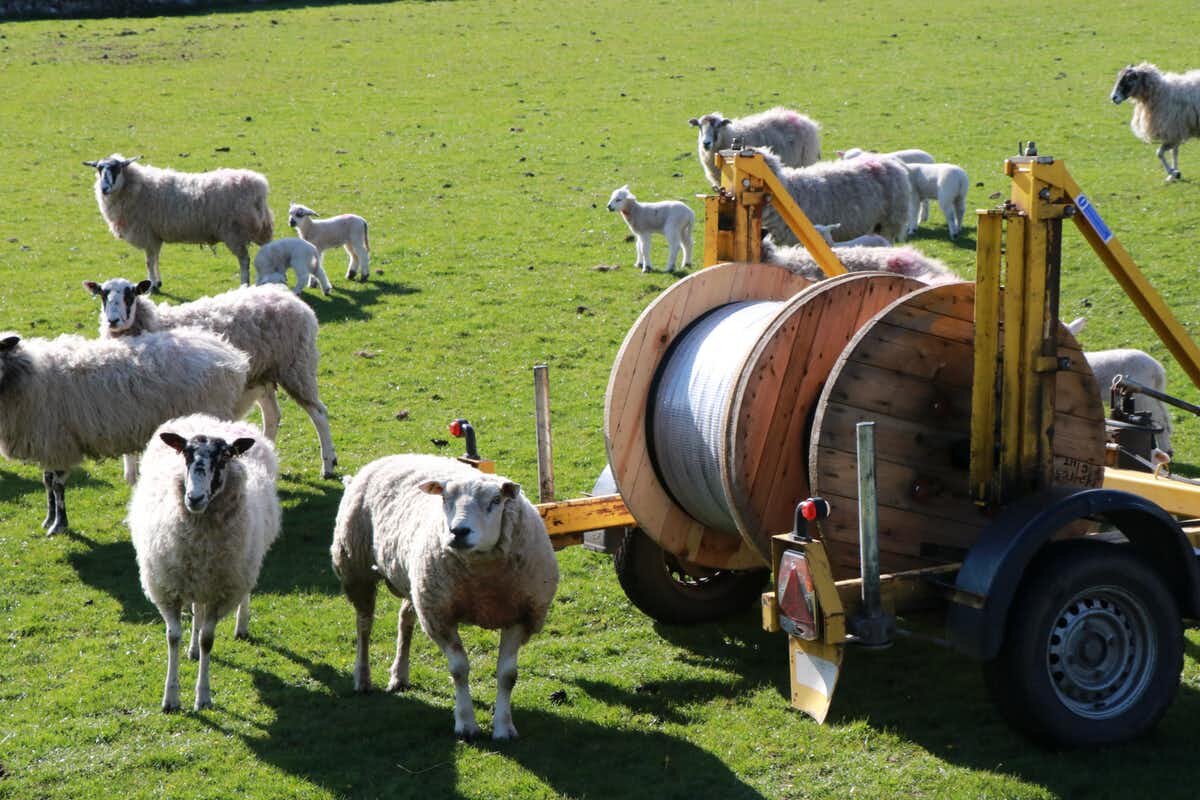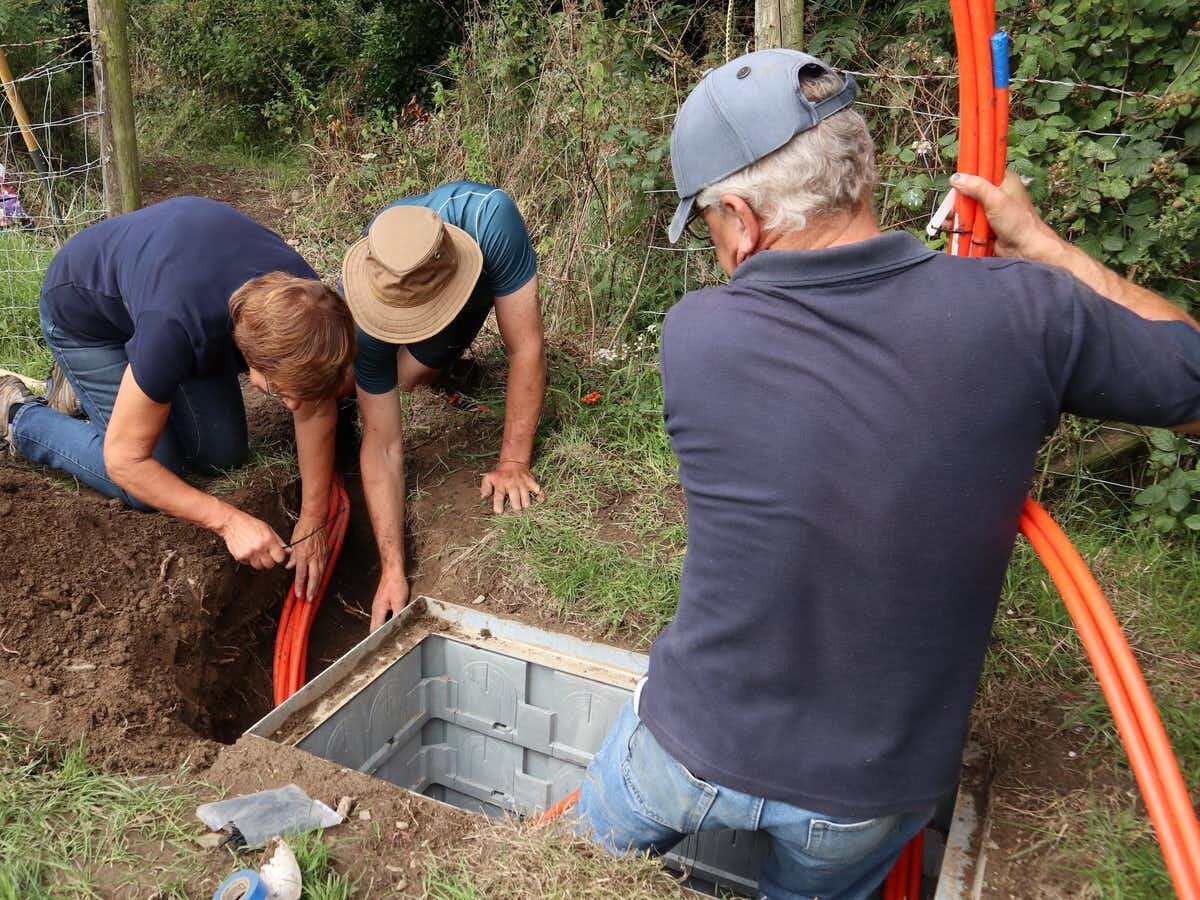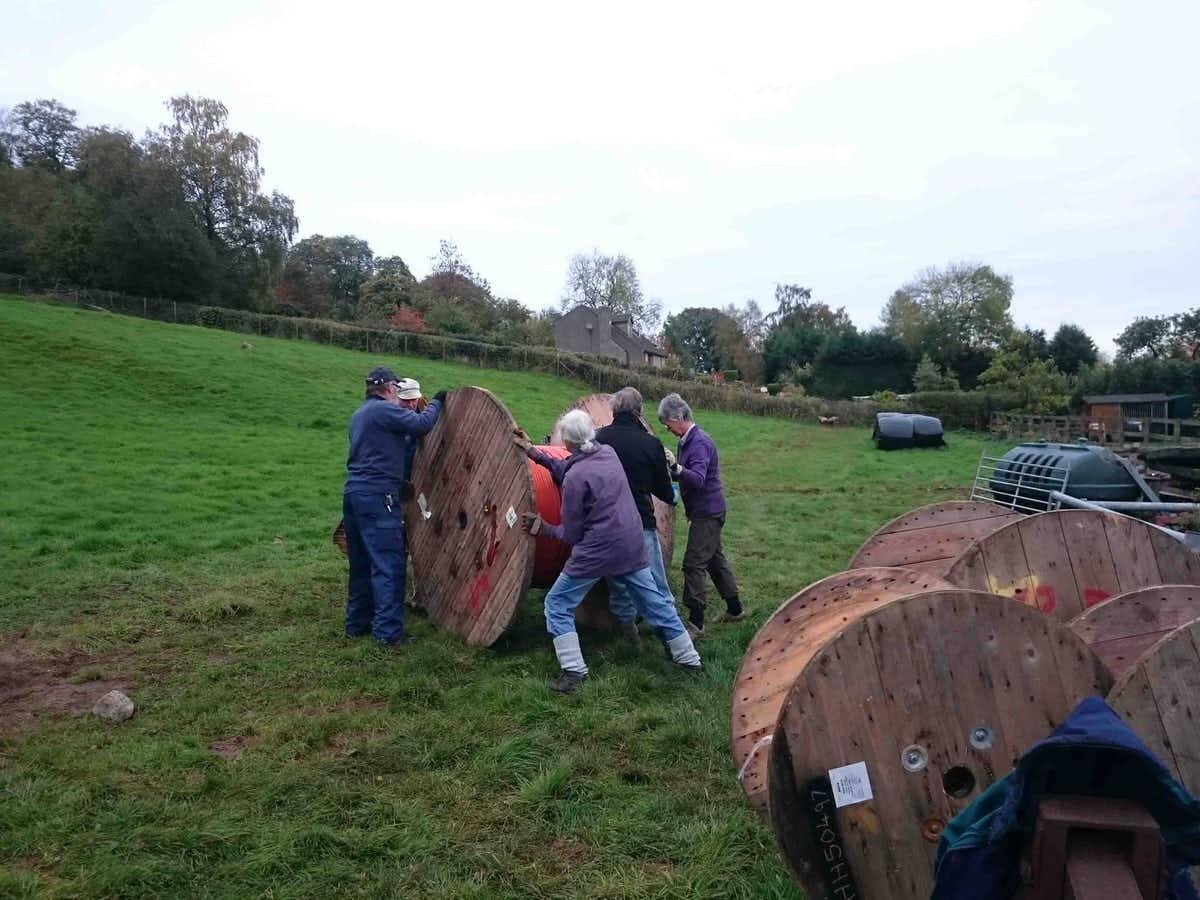English villages build their own superfast broadband, Ugandans assemble smart micro-grids, and Bristol communities reconcile climate and social justice
B4RN vehicle parked in a field in rural northwest England during a fibre installation
Sometimes the stories about localities deciding to use hi-tech to increase their autonomy and independence come roaring at you… here’s three:
The remote village that built one of the fastest digital networks in the UK
This is a great long read from The Conversation, which combines activism and academic research. Below is the opening of a piece which tells the exciting story of Broadband for the Rural North (or “B4RN”, beautifully shortened - a mix of the digital and the traditional). It’s a tale of high-technology directly and literally passing through the hands of locals - but also about how that’s more deeply driven by strong human ties and mutual commitments.
From the writer, Kira Allman:
Nestled between Lancashire’s stand-out beauty, the Forest of Bowland, and the breathtaking vistas of the Yorkshire Dales, the serene, postcard-perfect village of Clapham seems far removed from the COVID-19 pandemic. But when the British government announced a nationwide lockdown in mid-March, Clapham went on high alert.
Local residents formed what they dubbed “Clapham COBRA”, a volunteer emergency response initiative that aimed to mitigate the negative effects of isolation by sharing information, delivering supplies, and checking in on one another.
Like many rural villages, Clapham is fairly geographically isolated and home to an ageing population, with most of its roughly 600 residents over the age of 45. But when it came to confronting extreme isolation, it also has a unique advantage: unlike much of rural England, Clapham boasts one of the best internet connections in the country – and the locals built it themselves.
Ann Sheridan remembers well the moment she got Broadband for the Rural North, known as “B4RN” (pronounced “barn”), to her farm in Clapham in March 2016. She recounted to me over the phone:
I remember my next-door neighbours nearly coming to blows because their son downloaded the whole series of Game of Thrones on a 2 megabits per second (Mbps) internet connection. And none of them could do anything else on the internet for days, right? So it was obvious that if the community wasn’t going to be left behind … we had to do something.
B4RN started planning to roll out its fibre-to-the-home network in Clapham in 2014, and by the end of 2018, around 180 homes out of 300 in the village had been hooked up with an affordable full gigabit-per-second symmetrical connection (currently only around 10% of homes in Britain are even capable of receiving such a connection).
The speeds are impressive, especially in a rural context where internet connectivity lags horrendously behind urban areas in Britain. Rural download speeds average around 28Mbps, compared to 62.9Mbps on average in urban areas. B4RN, meanwhile, delivers 1,000Mbps.
The internet is more important than ever during the lockdown, where lack of access exposes other inequalities in internet use and skills. But B4RN means much more to digitally and geographically isolated communities than the internet service it provides.
B4RN is registered as a Community Benefit Society, which means the business belongs to the communities who need it: community members own the enterprise, and in B4RN’s case, they also actually build a lot of the infrastructure themselves.
As a result, the process of “getting” B4RN involves a substantial commitment – of time, training, money, and physical labour.





Ann Sheridan was a B4RN “champions”, meaning that she headed the volunteer effort to build B4RN in her village. The role involved “all kinds of things”, she recalls. Building a fibre-optic internet network from scratch involves a steep learning curve and a lot of teamwork.
Community members need to map their coverage area, secure permissions (called wayleaves) to cross their neighbours’ land, and dig trenches across fields and gardens to lay plastic ducting for the fibre-optic cable.
In the end, the connections B4RN facilitates in a place like Clapham are more than technological – they’re personal. And the impact of those connections is especially evident now. “Everybody in the village knows every everyone, it was like that anyway,” Sheridan explains. “But B4RN put rocket boosters under it.”
Over the last year, I have visited and spoken with people in many different communities that have had a hand in building B4RN, and each time I have heard a similar story: you dig B4RN into your own back garden, but B4RN also digs into you.
The mutual understanding and genuine friendships fostered among local people during the building process last well beyond the installation itself. In Clapham, the collaborative effort that went into B4RN contributed to a pre-existing rapport that helped in the face of the coronavirus lockdown.
As Sheridan put it: “We know each other. We know our strengths and weaknesses, so we can just crack on with things.”
Smart, low-carbon mini grids are putting power back with the people
From Wired magazine and MIT Technology Review, here’s the story of Modularity Grid. It’s a London-based start-up whose focus is on electrical micro-grids, which can potentially service the 11% of the world that still doesn’t have an electricity service (MG are testing out on low-income communities in Uganda).
The problems that MG solves is that most micro-grids are custom-built, designed for particular sets of households, thus are more expensive and inefficient in their provision of energy.
According to Wired magazine:
Elizabeth Nyeko
Founder Elizabeth Nyeko and her team have piloted technology that harnesses machine learning to help mini-grid operators track and predict energy consumption more effectively.
The system connects the various components in a mini-grid and collects enormous amounts of data in real-time, including information about how much electricity has been generated and used. It then ensures that uninterrupted electricity is available throughout the mini-grid by managing supply and demand accordingly, as well as prioritising critical users such as hospitals in the event of a shortage.
“In most conventional systems today, you have to hardwire the amount of energy that each user receives. But with Modularity Grid, you can easily change the amount of energy delivered to each user, or the number of households linked to the mini-grid,” says Nyeko. “This essentially creates a modular, plug-and-play system that can be scaled up or down as and when needed.”
The advantages of such a predictive and adaptive system are numerous. For instance, energy suppliers no longer have to oversize their mini-grids or overspend on batteries to store extra electricity, thereby decreasing uncertainty and saving money on hardware.
And from MIT Tech Review:
Nyeko designed an intelligent cloud-based platform that enables mini-grid operators to better track and predict individual consumption; it then redirects excess electricity to specific users in need of constant power, called “anchor loads.”
At the Mandulis site in Uganda, where Nyeko is piloting her Modularity Grid solution, the anchor loads include the village rice mill—which also provides the rice husks used to fuel the mini-grid itself.
“If we can deliver just the amount of electricity to people that they need, and redirect the rest to something that creates value for a rural community, we can make mini-grids viable in a low-income setting,” Nyeko says.
It seems obvious to us that such a clever micro-grid, connected to local sustainable energy generation (like Park Slope’s solar arrays in Brooklyn), not only works for low-income African communities but any community that seeks resilience and self-reliance in these unstable times.
Britain beyond lockdown: can social and climate justice come together?
Amidst an excellent report from the Guardian on how Bristol is bringing together activism around social and climate justice, we found this vignette about Bristol’s working-class community of Lawrence Weston. They’re really building their purpose (with the assistance of forces like the Big Local fund), so they can lay their hands on energy tech that can tangibly return savings and profits to their community.
From the Guardian:
A post-war housing estate in north-west Bristol, Lawrence Weston is one of the lowest income neighbourhoods in the UK, but it has also gone further than most in marrying local social concerns with climate strategy. This is thanks to a strong community spirit, a supportive council and a nimbleness in adapting to crises.
During the depths of austerity in 2012, the city threatened to close the local youth centre, so a group of residents took over the building and made it a community hub for debt advice, mental health counselling, veterinary advice, craft workshops and classes for zumba and kickboxing. During lockdown, they have repurposed the building once again as a distribution hub for food parcels and prescription deliveries.
Mark Pepper, a lifelong resident who works full-time as the project development manager of Ambition Lawrence Weston, said the lockdown had strengthened the community and made people more determined to push ahead with infrastructure projects that could make them more resilient to future shocks.
He says residents realise they can make money and save the planet at the same time. Helped by donors, including a lottery-funded Big Local budget and a 50% share in the profits of a solar power plant, they have hired specialist consultants to help them draw up an ambitious community action plan to build affordable, environmentally friendly housing, install new charging points for electric cars and improve cycle access.
Residents – 70% of whom say they struggle to pay heating and electricity bills – can use a mobile phone app that employs thermal imaging to spot weaknesses in the energy efficiency of their homes. Local traders then fix the draughty windows and insulate the lofts, but only charge a fee to those who can afford it.
“We’re doing a lot on climate, but only by accident,” Pepper says. “We used to think the climate was a middle class problem, that had nothing to do with us because we have low car ownership and few people take foreign holidays. Our residents have more pressing worries like paying the rent, heating their homes and buying enough food for their families.
But they now see it as a way of investing in the future. Later this month, Pepper – who left school with no qualifications – is expecting a response to the community’s proposal to build a £5.4m wind turbine. The planned 4.5MW tower would be erected 3km from Lawrence Weston and generate enough electricity to power 3,850 homes and generate an income for the community of between £50,000 and £400,000 a year depending on borrowing costs.
“We want an economic return as well as a reduced carbon footprint. We’ll use the cash for a training academy so that residents can get good jobs in renewable technology, energy efficiency and passive building construction,” Pepper says.
For him, this is a question of independence. “We hope that after Covid there is more recognition for grass-roots social infrastructure that enables us to help ourselves more,” he said.
Encouraging more collective ownership may seem a thousand miles away from the government’s policies, but many believe this is key to engaging a wider community to reduce emissions, care for nature, and address prejudice and inequality.
Other countries have demonstrated that this coming together of people, energy and land does not need to be a distant utopia.
More here. And here’s links to our archives on localism, community power and energy.



